Class 112/3 Cravens 2-car DMUs
Images

51684
circa August 1959
The drivers compartment of DMBS M51684, taken at Darnall presumably when new in August 1959. It was one of the 100 Cravens power cars fitted with Rolls-Royce engines, and one of the 50 of these with mechanical transmission, later known as a Class 112. Delivered to Newton Heath, it would also spend time at Gorton, Accrington and Cricklewood before withdrawal in 1968 after just over nine years in service. Cravens.

51684
circa August 1959
New Rolls-Royce powered Cravens power-twin M51684 and presumably M51709 circa August 1959. The image is matted as it was used in a company publicity advert. Cravens.

circa 1959/1960
This is a train from Liverpool Lime Street entering Chester General; taken about 1959 or 1960. There was a regular train service between the two cities via Runcorn; I traveled on it a number of times, and it always seemed to be on a Cravens set. The service was worked from the Liverpool end, and I've always assumed that these Cravens sets were based on Merseyside, perhaps at Allerton; however, I'm sure they had all gone from Lime Street by 1960 - from what I remember, local services were worked by class 108s by that time, mainly ones with roof mounted four-position route indicators. David Faircloth.

51701
8th February 1961
Taken soon after the accident at Royton on 8/2/61, 51701 on the left and its DMC hard against it. Richard Greenwood.

8th February 1961
The DMC involved in the Royton accident on 8/2/61 after it had been pulled back from M51701. Richard Greenwood.

51701
8th February 1961
M51701 embedded into 13-15 High Barn Street, Royton, on 8/2/61. Richard Greenwood.

51701
8th February 1961
DMBS M51701 on the left and its DMC on the right, taken in High Barn Street, Royton, 8/2/61. Richard Greenwood.

51701
8th February 1961
The badly damaged M51701 after the collision at Royton on 8/2/61. It would be repaired and returned to traffic. Richard Greenwood.

51701
8th February 1961
M51701 in the rubble of 13-15 High Barn Street, Royton, on 8/2/61. Richard Greenwood.

51701
8th February 1961
By midday on 8/2/61 a ramp had been built to the left to lift M51701 into Royton station. Richard Greenwood.

51701
8th February 1961
M51701 is being slowly moved to the left towards the ramp that will take it up to Royton station, 8/2/61. Richard Greenwood.

27th May 1961
A Rolls-Royce powered Cravens DMU at seen in Preston station on May 27th, 1961. The second set appears to be a Derby Lightweight. Michael Mensing.

51725
4th June 1961
M51725 and M52057 at Manchester Victoria 4th June 1961.
51725 is a DMCL of Class 112/1 built by Cravens and delivered in October 1959 fitted with a Rolls-Royce 238 bhp engine and a standard mechanical transmittion it was withdrawn in November 1968 and scrapped at G.Cohen Kettering in April 1970.
52057 is a DMCL of Class 108/1 built by Derby Works and delivered in January 1961 fitted with two BUT 150 bhp engines and a standard mechanical transmission it was withdrawn in April 1992 and scrapped at Gwent Demolition Margam in May of the same year. Keith Long.

June 1962
A Manchester bound Rolls-Royce powered Cravens two-car unit passes the 1950 BR-built signal box at Agecroft Junction in June 1962. Dominating the background are Agecroft colliery and power station, both now long-gone. The 'box closed in 1988.
Scanned from a 35mm size negative taken by the late Cyril Golding, now the copyright of the Industrial Railway Society. Kevin Lane Collection.

51711
1st September 1962
Two Rolls-Royce engined Cravens DMUs in Blackburn station on 1 September 1962 with the 10.47am Colne-Blackpool service. Closest is DMBCL M51711. Michael Mensing.

51709
circa 1963
The west end of Accrington carriage shed, with 51684 / 51709 nearest the camera, along with 2 113's, and probably 4 other 112's. Believed to be circa 1963, as the stationary steam loco that was used to heat carriages, and was kept in front of the building with the chimney, has gone, and all the vans are believed to be stored. Accrington shed closed to steam on 5th March 1961. It became 10E in 1963, and closed on 2nd October 1972. The depot was used for storage after this date, and was apparently demolished circa 1974-75. Andrew Dyson Collection.

Date unknown
A two-car Cravens set at Ramsbottom on the East Lancs Line, date unknown. It is a power twin, the single exhaust pipe protruding through the roof on each vehicle means that this was a Rolls-Royce powered set, later know as a Class 112.
This could be a Manchester - Accrington or a Bacup service. Stuart Mackay Collection.
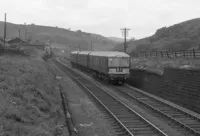
circa mid-1960s
A three-car DMU seen after passing Summit East signal box, looking north towards Walsden circa mid-1960s.
Formed of a Rolls-Royce powered Cravens DMBS working with a BRC&W Calder Valley TSL and DMBC, they all have the same cleanliness of roofs suggesting it wasn't a random makeshift set. Stuart Mackay Collection.

circa mid-1960s
A Rolls-Royce powered Cravens set heading for Manchester at Waltons Siding on the Blackburn to Bolton line between Entwistle and Sough Tunnel in the mid 1960s. Walter Burt.

51706
7th August 1965
Rolls-Royce powered Cravens twin set M51706 + M51685 waits to leave Royton with the 13.45 (SO) departure to Manchester on 7 August 1965. The short line to Royton Junction on the Oldham Loop line closed on 16 April 1966.
Scanned from a 6x9cm negative taken by Brian Barlow, copyright of the Industrial Railway Society. Kevin Lane Collection.

1966
A Rolls Royce Cravens set (Class 112) at Southport in 1966. David Faircloth.

1st October 1966
A six-car DMU formation in Blackpool North station on 1 October 1966.
Closest is a two-car Cravens, the crest on the non-brake vehicle suggests this is a power car (and there is a hint of an exhaust on the roof by the pillar). A Cravens power car without any fillers on the no.2 bodyside means it is a Rolls-Royce powered vehicle. Alan Grange.

3rd December 1966
A Cravens unit (Class 105 or 112?) at Helmshore railway station on the day of closure, 03/12/66. The headboard reads "The Last Train, Accrington - Bury - Accrington, Saturday Dec. 3rd 1966". DH Dyson.
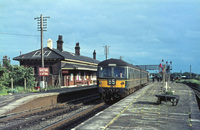
20th June 1967
One of the Rolls-Royce powered Cravens DMUs at Garstang & Catterall station on 20 June 1967. George Woods.

28th April 1968
Two Rolls-Royce powered Cravens sets seen at Entwistle on 28/4/68, one with mechanical transmission (Class 112) and one with hydraulic transmission (Class 113, on the right). Accrington is thought to have just one of the former at this time (51704/51729), the other sets were now at Cricklewood and this set would move there in June. George Woods.

51684
1969
A row of condemned Rolls-Royce powered Cravens cars at Wymondham in 1969. There are fifteen vehicles visible, M51684 being the closest. It was still in green, but more than half the others are in blue, with a variety of yellow end styles - for example the second vehicle has a yellow panel, the fourth has yellow cab doors.
These would have been withdrawn from Cricklewood in November 1968, the vehicle seeing just nine years in traffic. They would be cut by Kings at Wymondham. Stuart Mackay Collection.
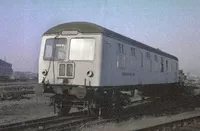
51692
15th February 1982
Class 112 DMBS 51692 at BSC Shotton on 15 February 1982.
It had been bought, along with 51691, from Birds at Long Marston in the early 1970s for use as permanent way vehicles at the steelworks, and they would be painted into a grey livery.
It looks like it had been out of use for some time in this image, and is believed to have been cut up on site at some point over the next couple of years. Steve Large.

circa November 1959
The Rolls-Royce engine under a Cravens power car. It is fitted with hydraulic transmission - the Twin-Disc torque converter is on the left hand side. Prominent on this side of the engine is the fuel pump, with four flexible air lines coming from pipes behind the solebar to the throttle motor at the bottom of the fuel pump - each pipe corresponding to a position on the drivers throttle controller in the cab. Cravens.

51735
circa December 1959
A publicity image of a Rolls-Royce powered Cravens set with hydraulic transmission, later known as a Class 113. Closest is DMBS M51735, the DMBCL is presumably M51760, the pair were delivered in early December 1959 to Accrington, and this was taken at Darnall station. Cravens.

51735
circa December 1959
A publicity image of DMBS M51735 outside the Cravens works at Darnall, Sheffield. It was new in early December 1959. Cravens.

6th May 1960
A Class 113 sits in Accrington steam maintenance shed on Friday 6th May 1960. The two steam loco's (believed to be 46112 'Sherwood Forester' left and 46100 'Royal Scot' right) are on shed to work Blackburn to London football specials, for Blackburn Rovers v Wolverhampton Wanderers FA Cup final the following day. DH Dyson.

27th May 1961
A Rolls-Royce hydraulic Cravens set is seen stabled in the sidings beside Preston station on May 27th, 1961. Michael Mensing.
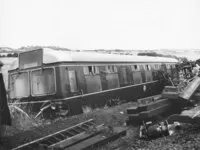
51780
16th July 1961
One of a series of images credited to the LMR Mechanical & Electrical Engineers Department at Derby recording the aftermath of the collision on Singleton Bank (near Weeton) where a six-car DMU excursion struck the rear of a stationary ballast train on 16 July 1961.
This is image 1, captioned "3rd. diesel rail car M.51780. Leading End after being moved from track."
The vehicle was the third car in the train and was barely a year old. It would not be returned to traffic. British Railways.
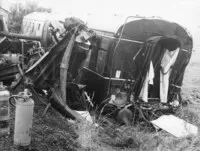
51780
16th July 1961
One of a series of images credited to the LMR Mechanical & Electrical Engineers Department at Derby recording the aftermath of the collision on Singleton Bank (near Weeton) where a six-car DMU excursion struck the rear of a stationary ballast train on 16 July 1961.
This is image 2, captioned "3rd. diesel rail car M.51780. Trailing End after being moved from track." British Railways.
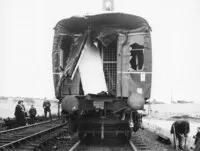
51755
16th July 1961
One of a series of images credited to the LMR Mechanical & Electrical Engineers Department at Derby recording the aftermath of the collision on Singleton Bank (near Weeton) where a six-car DMU excursion struck the rear of a stationary ballast train on 16 July 1961.
This is image 3, captioned "4th. diesel rail car M.51755. Leading End."
The vehicle was the fourth car in the train, the partner to M51780. Clearly it is the rear end of the vehicle, 'leading end' in the caption probably refers to this end being the leading end at the time of the collision. It would be repaired and returned to traffic. British Railways.
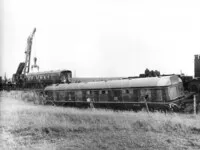
51780
16th July 1961
One of a series of images credited to the LMR Mechanical & Electrical Engineers Department at Derby recording the aftermath of the collision on Singleton Bank (near Weeton) where a six-car DMU excursion struck the rear of a stationary ballast train on 16 July 1961.
This is image 6, captioned "3rd. diesel rail car M.51780. In field after being moved from track."
Behind, under the crane, is M51755, these two vehicles formed the second of the three two-car sets in the train. British Railways.
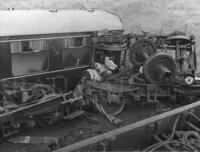
51780
16th July 1961
One of a series of images credited to the LMR Mechanical & Electrical Engineers Department at Derby recording the aftermath of the collision on Singleton Bank (near Weeton) where a six-car DMU excursion struck the rear of a stationary ballast train on 16 July 1961.
This is image 7, captioned "3rd. diesel rail car No. 51780. Rear end with bogies from 1st. & 2nd. vehicles Nos. M.50808 M.50783."
The vehicle was the third car in the train and was barely a year old. It would not be returned to traffic. British Railways.
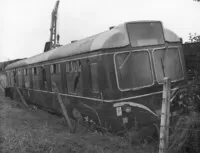
51780
16th July 1961
One of a series of images credited to the LMR Mechanical & Electrical Engineers Department at Derby recording the aftermath of the collision on Singleton Bank (near Weeton) where a six-car DMU excursion struck the rear of a stationary ballast train on 16 July 1961.
This is image 8, captioned "3rd. diesel rail car M.51780 (leading end) after being moved from track." British Railways.
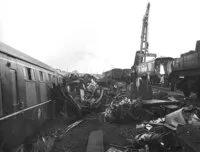
51780
16th July 1961
One of a series of images credited to the LMR Mechanical & Electrical Engineers Department at Derby recording the aftermath of the collision on Singleton Bank (near Weeton) where a six-car DMU excursion struck the rear of a stationary ballast train on 16 July 1961.
This is image 9, captioned "Engines etc. from 1st. three vehicles (up main line) of diesel M.U. train."
On the left is M51780 and M51755 is on the track under the crane. British Railways.
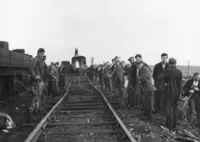
51755
16th July 1961
One of a series of images credited to the LMR Mechanical & Electrical Engineers Department at Derby recording the aftermath of the collision on Singleton Bank (near Weeton) where a six-car DMU excursion struck the rear of a stationary ballast train on 16 July 1961.
This is image 15, captioned "Down main line looking to rear of diesel M.U. train." British Railways.

51780
16th July 1961
One of a series of images credited to the LMR Mechanical & Electrical Engineers Department at Derby recording the aftermath of the collision on Singleton Bank (near Weeton) where a six-car DMU excursion struck the rear of a stationary ballast train on 16 July 1961.
This is image 17, captioned "Detached bogies on bank, diesel M.U. train".
Behind is M51780. British Railways.

51755
16th July 1961
One of a series of images credited to the LMR Mechanical & Electrical Engineers Department at Derby recording the aftermath of the collision on Singleton Bank (near Weeton) where a six-car DMU excursion struck the rear of a stationary ballast train on 16 July 1961.
This is image 18, captioned "Trailing end of 4th. diesel rail car M.51755." British Railways.
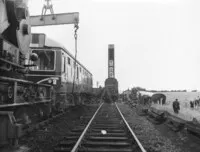
51755
16th July 1961
One of a series of images credited to the LMR Mechanical & Electrical Engineers Department at Derby recording the aftermath of the collision on Singleton Bank (near Weeton) where a six-car DMU excursion struck the rear of a stationary ballast train on 16 July 1961.
This is image 20, captioned "4th. diesel rail car M.51755 on down line. 3rd. diesel rail car M.51780 at right of up up main line." British Railways.

51755
16th July 1961
One of a series of images credited to the LMR Mechanical & Electrical Engineers Department at Derby recording the aftermath of the collision on Singleton Bank (near Weeton) where a six-car DMU excursion struck the rear of a stationary ballast train on 16 July 1961.
This is image 23, captioned "Up main line ballast train freight vehicles on right."
Beyond the wagons can be seen the rear end of M51755, its partner M51780 is in the field to the left. A DMU engine sits on the track. British Railways.
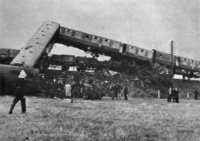
51780
16th July 1961
The wreckage of the 8.50am Colne to Fleetwood service after colliding with a ballast train at Singleton Bank (near Weeton) on 16 July 1961. From left to right are 50808, 50783, 51780 and 51755. Image taken from the accident report. British Railways.

4th November 1961
The last days of the 1866-built Burnley Manchester Road, with a Preston to Todmorden service formed of a two-car Rolls-Royce diesel hydraulic Cravens DMU (Class '113') running into the up platform, with just one passenger and two railfans present on Saturday 4th November 1961. The closure notice can be noted on the down platform building, the station closing to passengers on the following Monday, 6th November 1961. Gordon Edgar Collection.

51737
17th December 1961
DMBS of Class 113 No M51737 stands at the refueling shed at Neville Hill Leeds after arriving with a special train from Manchester on Sunday 17th December 1961.
Delivered in December 1959 and built by Cravens at Sheffield, fitted with a Rolls-Royce 238 bhp engine and a Hydraulic Torque converter it was withdrawn in July 1969 and scrapped at T. W. Wards Briton Ferry in July 1970. Keith Long.
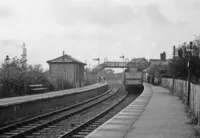
Date unknown
A Rolls-Royce powered Cravens hydraulic DMU arrives into Clifton Junction station. The headcode, B7, suggests that this was a Manchester Victoria to Colne service via Clifton Jn, Bury Bolton St, Ramsbottom and Accrington. Circa mid-1960s. Harvey Scowcroft / Nigel Valentine Collection.

51732
Date unknown
Rolls-Royce powered Cravens DMBS M51732 presumably on Cricklewood depot where it was allocated from 1962 to 1967. Stuart Mackay Collection.

51739
Date unknown
Two Cravens DMUs, at least the leading set has Rolls-Royce engines and hydraulic transmission (later becoming known as a Class 113). Seen at Chesterfield (Midland) station, looking north. Date unknown, only the leading car DMBS M51739 is still in green, so circa late 1960s, it was always allocated to Accrington depot. Graham Clark.

September 1963
A Rolls-Royce engined Cravens power-twin seen at Copy PIt with a Preston-Todmorden service in September 1963. Stuart Mackay Collection.

Date unknown
A Cravens Roll-Royce hydraulic unit passes Aspen Colliery Signal box (near Oswaldtwistle) in it's way to Manchester. DH Dyson.
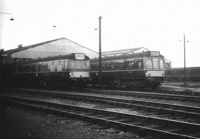
51734
March 1964
Cravens Local Passenger (later Class 113) 2-car dmu Nos.M51734 (113/2), M51763 (113/1) in green livery with small yellow panel (note large headcode panel with, uniquely to 113's, an integral destination blind) at Cricklewood MPD, 03/64. To the right is a BR (Derby) 4-car suburban dmu (later Class 127). Hugh Llewelyn.
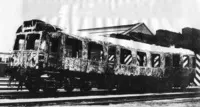
51770
circa April 1964
Not a great quality image but the content is of great interest showing a burnt out Class 113 DMCL. It is likely 51770 - a victim of a fire on board the 7.58am Skipton to Manchester train at Shoe Mill, Baxenden, on 12 March 1964 which moved to Doncaster Works for cutting. Michael Boot Collection.
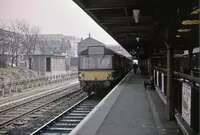
11th April 1964
A Rolls-Royce powered Cravens unit with hydraulic transmission, with another two-car on the rear, on a Kentish Town - Barking service DMU at Barking, 11 April 1964. John Cosford.

51744
17th July 1964
Two Cravens DMUs in Accrington station on 17 July 1964. On the right is M51744, one of the Rolls-Royce powered sets with hydraulic transmission. Stuart Mackay Collection.
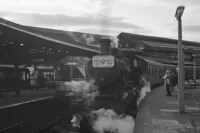
6th September 1964
An image of a special for the last day of the Preston - Southport line (West Lancashire Railway) on Sunday 6 September 1964, but worthy of adding here for the three Cravens DMUs on the left. Harvey Scowcroft / Nigel Valentine Collection.

51776
1965
Another lovely day in Manchester in 1965. They do have them. This Cravens unit is showing B0 which was the 2 character code for Manchester Vic to Bolton Trinity St but in a 4 character display. Edgehillsignallman@Flickr.
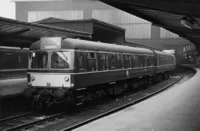
51755
29th August 1966
With M51755 closest an Accrington-based Cravens Rolls-Royce powered DMU with hydraulic transmission stands empty in Carlisle station at 2.27pm on 29 August 1966 (a bank holiday Monday). A Derby Lightweight sits behind it. Michael Mensing.
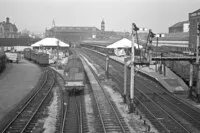
1968
A Rolls-Royce powered Cravens hydraulic DMU arrives into Bolton Trinity Street station sometime in 1968. Harvey Scowcroft / Nigel Valentine Collection.

16th March 1968
A Rolls-Royce powered Cravens DMU with hydraulic transmission (later a Class 113) with a Colne service on 16 March 1968. Seen approaching Hospital Crossing the the east of Bamber Bridge station, Brindle Road Crossing can be seen at the other side of the bridge. Stuart Mackay Collection.
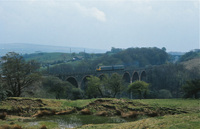
28th April 1968
A Rolls-Royce powered Cravens unit with hydraulic transmission (later known as a Class 113) crosses Entwistle Viaduct on 28.4.68. The closest vehicle has yellow cab doors, the far vehicle has just a small yellow panel. George Woods.

51740
23rd May 1968
A Rolls-Royce powered Cravens DMU seen with a Preston service to the east of Rishton station on 23 May 1968 led by M51740. Stuart Mackay Collection.

August 1968
Three hydraulic-transmission DMUs Cravens DMUs passing Lostock Hall in August 1968. Curly42.

51768
circa late 1960s
A two-car Rolls-Royce powered Cravens DMU just to the east of Rishton station - the destination blind has not been changed as it displays Blackburn. Date unknown, circa late 1960s. Accrington allocated M51768 leads, it was withdrawn in February 1969. Note the yellow cab door on the second vehicle. Stuart Mackay Collection.

51778
circa late 1960s
A two-car Rolls-Royce powered Cravens DMU on a Preston - Colne service to the east of Rishton station. Date unknown - circa late 1960s. Accrington allocated M51778 leads, it was withdrawn in April 1969. Stuart Mackay Collection.
Summary
Description
Drivers Instructions & Works Photos
Numbering
Liveries
Operations
Non-Passenger Use
Images
No vehicles were preserved.
Thanks to Andrew Dyson for additional information.


